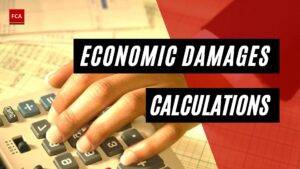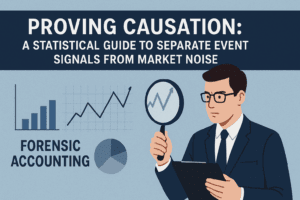Lost profits vs lost business value: when each applies is a critical distinction that can significantly impact the outcome of business litigation. When a company suffers economic damages, the difference between claiming lost profits or lost business value can amount to millions of dollars. However, many attorneys and business owners struggle to determine which approach best fits their specific situation.
The complexity of these damage calculations often requires the expertise of a forensic accounting expert witness or lost profits expert. Specifically, economic damages experts must carefully analyze whether the harm represents a temporary setback (lost profits) or permanent damage to the business’s value. In fact, choosing the wrong approach can lead to significantly undervalued claims or even case dismissal due to inappropriate damage theories.
This expert guide breaks down the fundamental differences between these two damage frameworks, explaining when each applies and how they’re calculated. By the time you finish reading, you’ll understand the key factors that determine which approach is appropriate for your case, the calculation methods used by lost business value experts, and how to avoid the common pitfall of double counting damages.
Understanding the Core Difference
The fundamental distinction between lost profits and lost business value centers on the nature and duration of economic harm. Understanding this core difference is essential for legal professionals and businesses to pursue appropriate compensation in commercial disputes. Let’s examine each approach and the key question that determines which applies.
Lost Profits: Temporary income loss from continued operations
Lost profits represent economic damages that occur while a business continues to operate but experiences reduced income for a defined timeframe. This measure calculates damages until the business regains the position it would have occupied had the harmful event never occurred .[1]
The calculation focuses on the incremental change in revenue directly attributable to the incident, plus or minus any changes in expenses related to the revenue change . As a forensic accountant expert witness might explain, lost profits reflect “the income the company would have gained after subtracting costs it avoided because of the disruption” .[1][2]
A cornerstone of any lost profits analysis involves the ‘but for’ scenario—projecting what the business would have earned without the damaging event . This approach typically applies in:[2]
- Breach of contract disputes
- Intellectual property cases
- General commercial litigation
Importantly, lost profits calculations generally occur before income tax deductions because these awards are taxable upon recovery .[1]
Lost Business Value: Permanent loss or closure of business
Conversely, lost business value damages arise from permanent harm—situations where a company never begins operations, ceases operations entirely, or permanently loses a segment of its business . This approach measures the complete worth of the affected business as of a specific date .[1][3]
A lost business value expert typically employs three valuation methods:
- Asset-based approach: Calculates the net equity of the business (most appropriate for holding companies)[1]
- Income method: Applies capitalization or discount rates to expected future earnings[1]
- Market approach: Bases business value on transactions of similar companies[1]
This valuation method essentially has the defendant “purchase” the destroyed business at its fair market value as of the loss date . Unlike lost profits, lost business value relies on net cash flow after deducting all expenses and commonly applies in shareholder disputes, family law matters, and cases involving business destruction .[4][5][1]
Key question: Is the loss finite or indefinite?
The critical determination between these approaches hinges on a simple question: is the economic damage temporary or permanent? Much like distinguishing between finite-lived and indefinite-lived intangible assets in accounting , this question guides the selection of the appropriate damages framework.[6]
Lost profits apply when harm will eventually end, allowing the business to recover. Meanwhile, lost business value becomes appropriate when damage is permanent or affects a business’s long-term viability.
Although these approaches generally remain mutually exclusive, rare exceptions exist. For instance, in a “slow death” scenario, a business might continue operating at reduced capacity before ultimately failing . Under these circumstances, a forensic accounting expert witness might calculate lost profits for the period the company continued operating, then measure lost business value as of the cessation date .[1][1]
The choice between these approaches carries substantial financial implications. While they often yield similar damages calculations, differences in methodology, particularly regarding discount rates and tax treatment, can lead to dramatically different outcomes .[4]
When to Use Lost Profits vs Lost Business Value
Choosing the right damage theory fundamentally affects litigation strategy and potential recovery amounts. The decision between lost profits and lost business value hinges primarily on case type, damage permanence, and specific fact patterns. Let’s examine exactly which approach applies in different case scenarios.
Lost Profits in breach of contract and IP cases
Breach of contract disputes typically warrant lost profits calculations when damage occurs within a finite timeframe. For example, if a supplier terminates a contract prematurely, the appropriate measure would be the profits lost during the remaining contract term . This approach works effectively when the breach affects income temporarily rather than destroying the underlying business.[7]
In intellectual property litigation, courts have established specific frameworks for lost profits claims. The widely-accepted Panduit factors provide a structured approach, requiring plaintiffs to demonstrate:
- Demand for the patented product
- Absence of acceptable non-infringing alternatives
- Manufacturing and marketing capability to exploit demand
- The amount of profit the patentee would have earned[8]
Furthermore, IP plaintiffs must show “a nexus of causation between sales lost and the infringement,” establishing that the infringement directly caused their decline in sales . Such cases fundamentally rely on the “but for” method, where experts project what the company would have earned without the infringement .[8][9]
Lost Business Value in shareholder disputes and business destruction
Shareholder disputes often necessitate business valuation rather than lost profits calculations. These cases typically involve:
- Dissenting shareholder actions regarding appraisal rights
- Minority oppression actions
- Cases guided by shareholder agreements[10]
According to valuation experts, shareholder disputes require determining fair value at specific points in time. Notably, dissenting shareholders prefer value determination as of the day before the meeting where they dissented, whereas minority oppression disputes use the date when the oppression began .[10]
Similarly, business destruction cases clearly call for lost business value calculations. When a wrongful act causes the complete loss or closure of a business, the appropriate measure becomes “the value of the business immediately prior to the wrongful act less any profits, compensation or salvage value received” . This approach additionally applies when a business segment is permanently eliminated , such as after fire damage or division elimination.[11][7]
Hybrid cases: When both may apply without overlap
Occasionally, damages experts must employ both methodologies in what’s called a “slow death” scenario. This occurs when a business continues operating at reduced capacity following a harmful event but ultimately fails . In such situations, lost profits would apply for the period the business continued operating, while lost business value would be calculated as of the cessation date .[1][7]
The key consideration in hybrid cases involves avoiding double recovery by ensuring damage periods don’t overlap . Experts must be exceptionally careful to separate the initial period (covered by lost profits) from the permanent damage (covered by lost business value) .[7][12]
As noted in the Dunkin’ Donuts franchise case, courts have upheld scenarios where lost profits exceeded the business’s entire value. This occurred because the lost opportunity represented a unique, measurable asset distinct from the underlying business value .[3]
Above all, experts must align their methodology with case facts and precedent. Selecting the appropriate damage theory requires thorough analysis of the nature, duration, and permanence of harm—something best accomplished through collaboration between counsel and qualified forensic accounting experts with valuation expertise.
Calculation Methods and Financial Models
Financial experts employ distinct calculation methodologies when quantifying lost profits versus lost business value. These specialized approaches ensure damages are accurately measured based on the nature of the economic harm. Understanding these methods proves critical for attorneys working with forensic accountant expert witnesses in commercial litigation.
Lost Profits: Before-and-after, yardstick, and ‘but for’ methods
Calculating lost profits fundamentally answers the question: what would the plaintiff have earned absent the damaging event? Three primary methodologies dominate this analysis:
The before-and-after method compares financial performance before and after the harmful event. This approach, considered among the most reliable by many courts, works best for companies with established operating histories showing steady performance. The expert analyzes profits before the incident, then measures the difference against actual results during the damage period .[13]
The yardstick method benchmarks performance against comparable businesses or industry standards. This approach proves especially valuable for companies lacking sufficient historical data or when external metrics better represent potential performance. The expert might use similar businesses, undamaged company locations, or industry averages as the “yardstick” .[14]
The ‘but for’ method projects what would have happened without the damaging event. As one expert explains, this involves “performing a ‘but for’ estimate of how the business would have performed had there been no incident” . The actual results are subtracted from these projections to calculate damages.[15]
Lost Business Value: Asset, income, and market approaches
Lost business value calculations typically employ three distinct approaches:
The asset-based approach calculates net equity by adjusting the book value of assets to reflect fair market value and subtracting liabilities. This method establishes a “floor value” most appropriate for holding companies or businesses with significant salable assets .[16]
The income approach converts anticipated economic benefits into present value. This involves projecting future cash flows and applying appropriate discount rates, making it suitable for operating companies with predictable earnings .[17]
The market approach values businesses by comparing them to similar entities with known transaction values. The expert derives valuation multiples from comparable sales and adjusts them to reflect differences between the transactions and the subject company .[18]
Discount rates: Pre-tax vs after-tax cash flow
Discount rates dramatically impact damage calculations, consequently making rate selection critical. A change of just a few percentage points can double or eliminate damages .[19]
Lost profits calculations typically use pre-tax cash flows and discount rates since these awards are taxable upon recovery . Conversely, lost business value relies on after-tax cash flows since this approach measures return to investors .[20][5]
Normalization adjustments in valuation
Normalization adjustments modify financial statements to reflect true business performance by eliminating anomalies. These adjustments fall into two categories:
Type 1 adjustments remove unusual or non-recurring items like one-time gains/losses or expenses unrelated to core operations .[21]
Type 2 adjustments address owner discretionary items such as excessive compensation or personal expenses paid through the business .[21]
These adjustments ensure damage calculations reflect the actual financial performance rather than accounting anomalies or owner preferences, thereby creating what valuation experts call a “public equivalent” income stream .[21]
Legal and Tax Considerations
Legal frameworks governing economic damages include crucial tax distinctions and timing considerations that directly impact recovery amounts. These elements often dictate the preferred damage theory in commercial disputes.
Tax treatment: Lost profits are taxable, lost value is not
The tax implications of damage awards fundamentally differ between these two approaches. Lost profits awards are taxable upon recovery, which is precisely why they’re calculated on a pre-tax basis . In contrast, lost business value compensation offers potential tax advantages.[1]
When a recovery compensates for injuries to capital assets (like business value), the payment constitutes a tax-free return of capital to the extent of the taxpayer’s basis in the damaged asset . Only amounts received in excess of this basis generate taxable income. As one tax court noted, recoveries for damage to capital assets can receive capital gain treatment, providing significant tax benefits .[22][22]
Valuation date rules: Known vs knowable events
The “known or knowable” principle represents a cornerstone concept in business valuation, creating critical distinctions between lost profits and lost business value calculations. This principle dictates that valuations should consider only facts and circumstances existing at the valuation date plus events occurring up to that date that could have been reasonably known, foreseen, understood, or comprehended .[23]
For instance, a customer agreement executed shortly after the valuation date would likely be considered “knowable” at the valuation date if negotiations were already underway . Nonetheless, a major storm causing significant damage shortly after the valuation date would typically fall outside the “knowable” boundary .[23][23]
Interestingly, lost profits calculations frequently consider subsequent events in determining damages, creating another significant distinction between these approaches .[7]
Avoiding double recovery: No overlap in damage periods
Courts universally recognize that a claimant can only be compensated once for any specific damage category . This principle becomes especially important in “slow death” scenarios where both lost profits and lost business value might apply.[2]
In such situations, experts must carefully delineate damage periods to avoid overlap . Typically, lost profits would apply for the period the business continued operating, while lost business value would be measured as of the cessation date .[1][1]
Ultimately, preventing double recovery maintains legal system integrity by ensuring damages reflect actual losses without duplication . This principle likewise underpins the careful selection between lost profits and lost business value theories.[24]
Role of Experts in Damage Assessment
Skilled professionals stand at the heart of economic damage calculations, bringing specialized expertise that can make or break high-stakes cases. With complex financial analyzes required for both lost profits and lost business value determinations, the right expert becomes a critical asset.
Importance of forensic accountants and valuation experts
Forensic accountants with business valuation expertise offer unmatched insights in commercial litigation. Those with advanced credentials—such as CPA, ABV (Accredited in Business Valuation), ASA (Accredited Senior Appraiser), or CFA (Chartered Financial Analyst)—bring crucial credibility to damage assessments . Some experts, like Richard Claywell, possess over 40 years of experience and hold multiple specialized certifications including Master’s in Business Valuation (MBV) alongside ASA, CBA, ABV, and other advanced credentials .[25][3]
Aligning methodology with case facts and legal precedent
Expert witnesses must tailor their approach to each unique case scenario. Throughout the litigation process, forensic experts assist legal counsel in identifying particular financial issues, creating discovery requests, and preparing for depositions . Crucially, they cannot simply accept management’s representations at face value—instead, they must examine underlying data with professional skepticism . This investigative mindset helps avoid reliance on faulty records that could undermine damage calculations.[26][27]
Documenting assumptions and financial models
Fundamentally, lost profits and business value experts must clearly document their methodologies and assumptions. When presenting their analysis, they systematically approach calculations by gathering relevant evidence, applying appropriate methodologies, and exercising professional judgment . The goal remains developing accurate, defensible calculations that hold up under courtroom scrutiny . Indeed, experts must tell a detailed, accurate story through their financial models while maintaining the scientific rigor demanded by legal standards.[26][28]
Conclusion
The distinction between lost profits and lost business value serves as a critical foundation for successful commercial litigation. Throughout this guide, we have examined how these two damage theories differ fundamentally in application, calculation methodology, and tax implications. Undoubtedly, choosing the appropriate approach significantly impacts potential recovery amounts and case outcomes.
Lost profits calculations best suit situations where businesses experience temporary setbacks yet continue operations. Meanwhile, lost business value assessments address permanent damage or complete business destruction. The selection between these approaches hinges primarily on whether economic harm is finite or indefinite in nature.
Financial experts employ distinct methodologies for each scenario. Lost profits typically rely on before-and-after comparisons, yardstick measurements, or “but for” projections. Conversely, lost business value calculations utilize asset-based, income, or market approaches to establish fair market value. Additionally, these approaches differ markedly in tax treatment—lost profits awards face taxation upon recovery, whereas lost business value compensation may qualify as a tax-free return of capital.
Regardless of which approach applies, qualified forensic accounting experts with business valuation credentials remain essential to developing defensible damage calculations. These professionals must carefully document assumptions, align methodologies with case facts, and avoid overlap that might constitute double recovery.
Above all, attorneys and business owners must understand these fundamental distinctions early in litigation. This knowledge allows for strategic case development, appropriate expert selection, and realistic recovery expectations. Though complex, mastering these damage theories ultimately strengthens your position whether representing plaintiffs seeking fair compensation or defendants challenging excessive claims.




